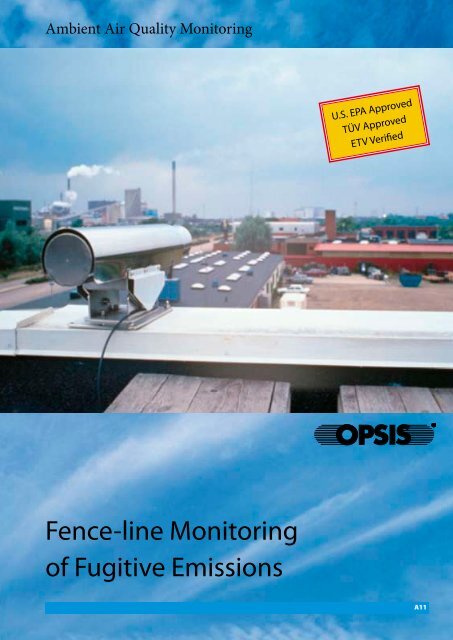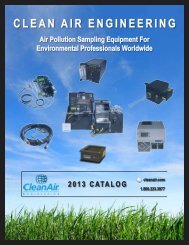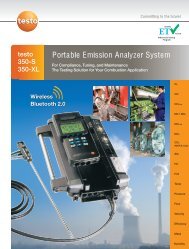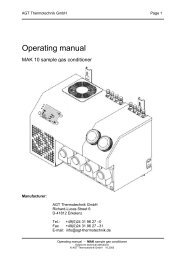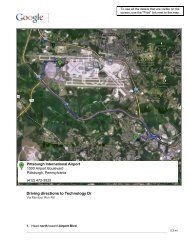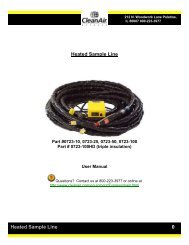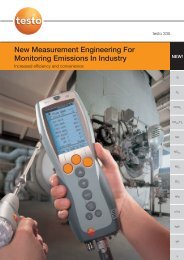Fence-line Monitoring of Fugitive Emissions - Clean Air Engineering
Fence-line Monitoring of Fugitive Emissions - Clean Air Engineering
Fence-line Monitoring of Fugitive Emissions - Clean Air Engineering
You also want an ePaper? Increase the reach of your titles
YUMPU automatically turns print PDFs into web optimized ePapers that Google loves.
Ambient <strong>Air</strong> Quality <strong>Monitoring</strong><br />
<strong>Fence</strong>-<strong>line</strong> <strong>Monitoring</strong><br />
<strong>of</strong> <strong>Fugitive</strong> <strong>Emissions</strong><br />
U.S. EPA Approved<br />
TÜV Approved<br />
ETV Verified<br />
A11
<strong>Fence</strong>-<strong>line</strong> <strong>Monitoring</strong> <strong>of</strong> <strong>Fugitive</strong> <strong>Emissions</strong><br />
An Opsis air quality monitoring system gathers data along one<br />
or more light paths, each <strong>of</strong> which may be some hundreds <strong>of</strong><br />
metres. This makes Opsis an ideal fence-<strong>line</strong> monitor, since a<br />
light path will act as a tripwire to detect fugitive emissions.<br />
An Opsis system will simultaneously monitor several userdefined<br />
compounds. More information is included on the<br />
reverse page, but typical examples are nitric oxide (NO), ammonia<br />
(NH 3), sulphur dioxide (SO 2), formaldehyde, benzene,<br />
toluene, phenol and other hydrocarbons. It is therefore possible<br />
to specify a system to monitor the emissions from for<br />
instance an industrial estate or a manufacturing complex.<br />
Because Opsis will monitor the entire length <strong>of</strong> a boundary,<br />
and because it monitors several compounds simultaneously,<br />
it is more efficient and cost-effective than a number <strong>of</strong> point<br />
monitors for individual compounds. Continuously generated<br />
data is stored by the system’s analyser. This allows information<br />
to be presented as averages for any user-defined interval<br />
– minutes, hours or days – either in real time or retrospectively.<br />
Opsis – the Total <strong>Monitoring</strong> Solution<br />
The Opsis long-path air quality monitoring system brings<br />
new standards <strong>of</strong> accuracy and data quality to environmental<br />
monitoring. Every minute, several thousand cubic metres<br />
<strong>of</strong> air interact with a beam <strong>of</strong> light between the light source<br />
– the emitter – and the receiver. When captured by the receiver,<br />
this light contains information on gases in the air it has<br />
penetrated.<br />
This information is extracted by spectrographic analysis.<br />
Results are logged as data that can be collected for further<br />
Meteorological<br />
stations<br />
Additional<br />
monitoring paths<br />
Automatic<br />
dust sampler<br />
Power supply<br />
Analysis <strong>of</strong><br />
additional gases<br />
Emitter Receiver<br />
<strong>Monitoring</strong> path (typically 1000–2500 ft<br />
in length)<br />
Analyser<br />
Auto-alignment<br />
capabilities<br />
The Opsis Technique<br />
A basic Opsis system includes an analyser connected by a fiber<br />
optic cable to a light path created by a light emitter and a receiver.<br />
Several light paths may be run from a single analyser.<br />
The system may be permanently installed or operated from a<br />
mobile facility such as a specially equipped vehicle.<br />
In either case the Analyser will accept data from other devices<br />
producing a 4–20 mA or a digital output. This allows<br />
information from meteorological sensors (wind strength and<br />
direction, temperature etc.) to be presented with air quality<br />
data to give a more detailed picture <strong>of</strong> environmental events.<br />
In the same way, Opsis will accept information from devices<br />
such as radiation monitors.<br />
Please refer to separate data sheets on the AR 500 series<br />
Analyser, on the ER 110 and ER 150 light emitter and receiver<br />
sets for fixed systems and on the ER 130 for mobile systems.<br />
Tests and Approvals<br />
Opsis has been tested and approved by a number <strong>of</strong> internationally<br />
recognized institutes and authorities. The system<br />
meets the requirements <strong>of</strong> the U.S. EPA and the German authorities.<br />
Full details are available on request.<br />
analysis by modem – from anywhere in the world.<br />
Opsis <strong>of</strong>fers the total monitoring solution including s<strong>of</strong>tware<br />
for data handling and management. In addition, Opsis<br />
<strong>of</strong>fers dust monitors and conventional analysers.<br />
Opsis technology is subject to a continual process <strong>of</strong> development.<br />
This, with the modular construction <strong>of</strong> Opsis systems,<br />
means that it is always possible to expand or update an<br />
installation without redundancy <strong>of</strong> viable equipment.<br />
Fiber<br />
optic<br />
cable<br />
EnviMan s<strong>of</strong>tware<br />
for data management<br />
Manual<br />
and automatic calibration<br />
Data acquisition
An Opsis system acting as a fence-<strong>line</strong> monitor detecting fugitive emissions<br />
Performance Data (typical data which may vary significantly depending on application)<br />
Compound Max.<br />
measurement<br />
range<br />
(500 m path) 3)<br />
AR 500/AR 520 Analyser<br />
NO 2<br />
SO 2<br />
O 3<br />
NO 2)<br />
NH 3 2)<br />
NO 3<br />
HNO 2<br />
HF<br />
Hg<br />
H 2O<br />
Styrene<br />
CS 2<br />
Formaldehyde<br />
Acetaldehyde<br />
Phenol<br />
Benzene<br />
Toluene<br />
p-, m-Xylene<br />
o-Xylene<br />
o-, m-, p-Cresol<br />
C 6H 5Cl<br />
C 6H 4Cl 2<br />
0-2000 µg/m 3<br />
0-5000 µg/m 3<br />
0-1000 µg/m 3<br />
0-2000 µg/m 3<br />
0-500 µg/m 3<br />
0-500 µg/m 3<br />
0-2000 µg/m 3<br />
0-2000 µg/m 3<br />
0-2000 ng/m 3<br />
0-100 g/m 3<br />
0-2000 µg/m 3<br />
0-2000 µg/m 3<br />
0-2000 µg/m 3<br />
0-2000 µg/m 3<br />
0-2000 µg/m 3<br />
0-2000 µg/m 3<br />
0-2000 µg/m 3<br />
0-2000 µg/m 3<br />
0-2000 µg/m 3<br />
0-2000 µg/m 3<br />
0-2000 µg/m 3<br />
0-2000 µg/m 3<br />
LD500 Laser Diode Gas Analyser<br />
CO 2)<br />
CO 2 2)<br />
NH 3<br />
HCl<br />
HF<br />
CH 4 2)<br />
H 2O 2)<br />
0–100 mg/m 3<br />
0–100 g/m 3<br />
0–100 mg/m 3<br />
0–100 mg/m 3<br />
0–10 mg/m 3<br />
0–100 mg/m 3<br />
0–100% vol.<br />
Min. detectable<br />
quantities<br />
(monitoring path<br />
500 m, measurement<br />
time 1 min.)<br />
1 µg/m 3<br />
1 µg/m 3<br />
3 µg/m 3<br />
2 µg/m 3<br />
2 µg/m 3<br />
0.1 µg/m 3<br />
1 µg/m 3<br />
20 µg/m 3<br />
20 ng/m 3<br />
0.2 g/m 3<br />
5 µg/m 3<br />
20 µg/m 3<br />
2 µg/m 3<br />
20 µg/m 3<br />
1 µg/m 3<br />
3 µg/m 3<br />
3 µg/m 3<br />
3 µg/m 3<br />
10 µg/m 3<br />
5 µg/m 3<br />
5 µg/m 3<br />
5 µg/m 3<br />
100 µg/m 3<br />
1 mg/m 3<br />
20 µg/m 3<br />
20 µg/m 3<br />
1 µg/m 3<br />
50 µg/m 3<br />
0.1% vol.<br />
Zero drift<br />
(500 m path,<br />
max.<br />
per month)<br />
±2 µg/m 3<br />
±2 µg/m 3<br />
±6 µg/m 3<br />
±4 µg/m 3<br />
±4 µg/m 3<br />
±0.2 µg/m 3<br />
±2 µg/m 3<br />
±40 µg/m 3<br />
±40 ng/m 3<br />
±0.4 g/m 3<br />
±10 µg/m 3<br />
±40 µg/m 3<br />
±4 µg/m 3<br />
±40 µg/m 3<br />
±2 µg/m 3<br />
±6 µg/m 3<br />
±6 µg/m 3<br />
±6 µg/m 3<br />
±20 µg/m 3<br />
±10 µg/m 3<br />
±10 µg/m 3<br />
±10 µg/m 3<br />
±200 µg/m 3<br />
±2 mg/m 3<br />
±40 µg/m 3<br />
±40 µg/m 3<br />
±2 µg/m 3<br />
±100 µg/m 3<br />
±0.2% vol.<br />
(1) When monitoring individual compounds, fiber optic cables <strong>of</strong> extended lengths<br />
are available.<br />
(2) Based on 200 m path. Recommended monitoring path length: 100 to 200 m.<br />
(3) Recommended monitoring path length: 300 to 800 m.<br />
• Besides the compounds above, the Opsis system monitors the following com-<br />
Span drift<br />
(per month,<br />
better than)<br />
Span drift<br />
(per year,<br />
better than)<br />
Linearity<br />
error<br />
(<strong>of</strong> measurement<br />
range,<br />
better than)<br />
Max. length <strong>of</strong><br />
fiber optic cable<br />
(when measuring<br />
several compounds)<br />
1)<br />
pounds: hydrogen cyanide (HCN), hydrogen bromide (HBr), hydrogen chloride<br />
(HCl), chlorine dioxide (ClO 2), chlorine (Cl 2), carbon dioxide (CO 2), phosgene (COCl 2),<br />
ethylbenzene (C 6H 5C 2H 5), methane (CH 4), ethane (C 2H 6), ethylene (C 2H 4), acrylonitrile<br />
(CH 2=CHCN), 1,2,4-trimethylbenzene, 1,3,5-trimethylbenzene and others.<br />
Please contact your Opsis supplier to discuss your particular system requirements, including the compounds you wish<br />
to monitor. Separate product sheets are available describing individual items <strong>of</strong> Opsis system hardware.<br />
Specifications subject to change without notice<br />
±2%<br />
±2%<br />
±2%<br />
±2%<br />
±2%<br />
±2%<br />
±2%<br />
±2%<br />
±2%<br />
±2%<br />
±2%<br />
±2%<br />
±2%<br />
±2%<br />
±2%<br />
±2%<br />
±2%<br />
±2%<br />
±2%<br />
±2%<br />
±2%<br />
±2%<br />
±2%<br />
±2%<br />
±2%<br />
±2%<br />
±2%<br />
±2%<br />
±2%<br />
±4%<br />
±4%<br />
±4%<br />
±4%<br />
±4%<br />
±4%<br />
±4%<br />
±4%<br />
±4%<br />
±4%<br />
±4%<br />
±4%<br />
±4%<br />
±4%<br />
±4%<br />
±4%<br />
±4%<br />
±4%<br />
±4%<br />
±4%<br />
±4%<br />
±4%<br />
±4%<br />
±4%<br />
±4%<br />
±4%<br />
±4%<br />
±4%<br />
±4%<br />
±1%<br />
±1%<br />
±1%<br />
±1%<br />
±1%<br />
±1%<br />
±1%<br />
±1%<br />
±1%<br />
±1%<br />
±1%<br />
±1%<br />
±1%<br />
±1%<br />
±1%<br />
±1%<br />
±1%<br />
±1%<br />
±1%<br />
±1%<br />
±1%<br />
±1%<br />
±1%<br />
±1%<br />
±1%<br />
±1%<br />
±1%<br />
±1%<br />
±1%<br />
10 m<br />
10 m<br />
10 m<br />
10 m<br />
10 m<br />
10 m<br />
10 m<br />
10 m<br />
10 m<br />
10 m<br />
10 m<br />
10 m<br />
10 m<br />
10 m<br />
10 m<br />
10 m<br />
10 m<br />
10 m<br />
10 m<br />
10 m<br />
10 m<br />
10 m<br />
10 m<br />
10 m<br />
10 m<br />
10 m<br />
10 m<br />
10 m<br />
10 m<br />
Hardware<br />
requirement<br />
AR 500/520<br />
AR 500/520<br />
AR 500/520<br />
AR 500/520<br />
AR 500/520<br />
AR 500/520<br />
AR 500/520<br />
AR 520<br />
AR 500/520<br />
AR 500/520<br />
AR 500/520<br />
AR 500/520<br />
AR 500/520<br />
AR 500/520<br />
AR 500/520<br />
AR 500/520<br />
AR 500/520<br />
AR 500/520<br />
AR 500/520<br />
AR 500/520<br />
AR 500/520<br />
AR 500/520<br />
LD500<br />
LD500<br />
LD500<br />
LD500<br />
LD500<br />
LD500<br />
LD500
Ambient <strong>Air</strong> Quality <strong>Monitoring</strong><br />
Why Opsis?<br />
Integrated UV and IR monitoring<br />
A great number <strong>of</strong> gases can be measured<br />
Total monitoring solution<br />
Cost-effective, open-path technology<br />
High-performance monitoring <strong>of</strong> criteria pollutants<br />
Representative path-integrated data<br />
Easily calibrated<br />
Operates with a minimum <strong>of</strong> maintenance<br />
U.S. EPA approved<br />
TÜV approved<br />
<strong>Clean</strong> <strong>Air</strong> <strong>Engineering</strong><br />
500 W. Wood Street<br />
Palatine, IL 60067<br />
Phone: (800)627-0033<br />
Fax: (847)991-3385<br />
E-mail: opsis@cleanair.com<br />
URL http://www.cleanair.com<br />
2007 02<br />
A11<br />
Opsis AB / Tempte & Tempte / Odenprint


